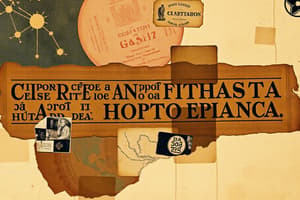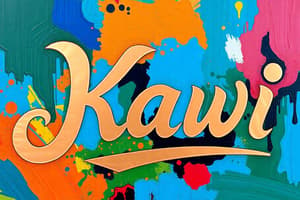Podcast
Questions and Answers
What key agricultural development occurred in the Tamil Nadu area by the fifth or sixth century?
What key agricultural development occurred in the Tamil Nadu area by the fifth or sixth century?
- The use of chemical fertilizers
- Large-scale cultivation began (correct)
- Advanced agricultural machinery
- Introduction of new crop varieties
Which crop was specifically mentioned as being cultivated due to the availability of water from channels?
Which crop was specifically mentioned as being cultivated due to the availability of water from channels?
- Millet
- Rice (correct)
- Wheat
- Barley
What was one of the methods used for irrigation mentioned in the content?
What was one of the methods used for irrigation mentioned in the content?
- Wells (correct)
- Drip irrigation
- Fog nets
- Hydroponics
What construction was necessary to prevent flooding in the delta region?
What construction was necessary to prevent flooding in the delta region?
In many areas, how many crops were typically grown in a year?
In many areas, how many crops were typically grown in a year?
What was a requirement for successful irrigation works mentioned in the content?
What was a requirement for successful irrigation works mentioned in the content?
What was used in some regions to collect rainwater for irrigation?
What was used in some regions to collect rainwater for irrigation?
What was one of the activities required in the preparation of land for agriculture?
What was one of the activities required in the preparation of land for agriculture?
What language is partially used in the land grant recorded on the copper plates?
What language is partially used in the land grant recorded on the copper plates?
What feature was NOT mentioned as part of the land described in the grant?
What feature was NOT mentioned as part of the land described in the grant?
What does the royal seal on the plates signify?
What does the royal seal on the plates signify?
Which of the following was used to demarcate the boundaries of the land?
Which of the following was used to demarcate the boundaries of the land?
What type of trees are explicitly mentioned as part of the land's contents?
What type of trees are explicitly mentioned as part of the land's contents?
Which of the following is NOT a type of water body mentioned in the land grant?
Which of the following is NOT a type of water body mentioned in the land grant?
How was the security of the copper plates ensured?
How was the security of the copper plates ensured?
Which item was included as part of the land's agricultural resources?
Which item was included as part of the land's agricultural resources?
Who was considered the most powerful Chola ruler?
Who was considered the most powerful Chola ruler?
Which territories were included in the Chola kingdom under Rajaraja I?
Which territories were included in the Chola kingdom under Rajaraja I?
What significant action did Rajendra I take during his reign?
What significant action did Rajendra I take during his reign?
Which architectural marvel was built by Rajaraja I?
Which architectural marvel was built by Rajaraja I?
What regions did Rajendra I invade?
What regions did Rajendra I invade?
What was one of the main achievements of Rajaraja I in terms of governance?
What was one of the main achievements of Rajaraja I in terms of governance?
What feature is noticeable about the temple at Gangaikondacholapuram?
What feature is noticeable about the temple at Gangaikondacholapuram?
Which of the following is true about the Chola kingdom's expansion?
Which of the following is true about the Chola kingdom's expansion?
What type of labor is depicted in the village scene?
What type of labor is depicted in the village scene?
Which tree is mentioned as having drums hanging from its branches?
Which tree is mentioned as having drums hanging from its branches?
What did the female laborer use to put her baby to sleep?
What did the female laborer use to put her baby to sleep?
What kind of animals are described as moving about in the village?
What kind of animals are described as moving about in the village?
What reason might the red-crested cocks be crowing for?
What reason might the red-crested cocks be crowing for?
What social activity is taking place among the Pulaiya women?
What social activity is taking place among the Pulaiya women?
What distinguishes the children in the village description?
What distinguishes the children in the village description?
Which of the following best represents the main activities described in the village?
Which of the following best represents the main activities described in the village?
What is a requirement for someone to become a member of the sabha?
What is a requirement for someone to become a member of the sabha?
What age range is specified for potential sabha members?
What age range is specified for potential sabha members?
Which of the following disqualifies a person from contesting for a committee position?
Which of the following disqualifies a person from contesting for a committee position?
What knowledge is expected of potential sabha members?
What knowledge is expected of potential sabha members?
In the context of the inscriptions, who were the Pulaiyas?
In the context of the inscriptions, who were the Pulaiyas?
Who cannot become a member of another committee according to the guidelines?
Who cannot become a member of another committee according to the guidelines?
What type of work is described in the Periyapuranam regarding the Pulaiyas?
What type of work is described in the Periyapuranam regarding the Pulaiyas?
Which of the following is NOT a qualifying characteristic for sabha members?
Which of the following is NOT a qualifying characteristic for sabha members?
Flashcards are hidden until you start studying
Study Notes
Copper Plates and Land Grants
- Copper plates from the 9th century document a land grant by a ruler, featuring inscriptions in Sanskrit and Tamil.
- The royal seal secures the plates, signifying authenticity of the land grant.
Details of the Land Grant
- The Chola kingdom land grant outlines specific land features including:
- Boundaries marked by earthen embankments and thorny bushes.
- Various assets included: fruit trees, gardens, wells, pastures, tanks, granaries, and rivers.
Chola Kingdom Expansion
- The Chola dynasty grew under rulers Vijayalaya, Rajaraja I, and Rajendra I, encompassing Pandyan and Pallava territories.
- Rajaraja I (reigned from 985) reorganized the administration and expanded the kingdom’s borders, including military campaigns to Sri Lanka and Southeast Asia.
- Rajendra I followed his father’s policies and developed a navy for expeditions.
Architectural Contributions
- Rajaraja I and Rajendra I commissioned monumental temples in Thanjavur and Gangaikonda-cholapuram, noted for their architectural design and bronze sculptures.
Agricultural Advancements
- Agriculture in Tamil Nadu flourished from the 5th or 6th century; large-scale cultivation required land clearing and leveling.
- Embankments were necessary to prevent flooding and irrigation systems, including canals and tanks for rainwater collection, were implemented for crop cultivation.
Role of Bronze Sculptures
- Chola bronze sculptures are distinguished by intricate decorations, reflecting the artistic achievements of the period.
Election to Sabha Membership
- Uttaramerur inscriptions defined eligibility criteria for sabha (local assembly) membership, requiring:
- Land ownership and residency.
- Knowledge of Vedas and administrative skills.
- Age restrictions (35 to 70 years).
- Prior committee members ineligible for new committees for three years.
Insights from Periyapuranam
- The Periyapuranam offers a glimpse into the lives of marginalized communities, depicting everyday life in a hamlet inhabited by Pulaiyas, including agrarian labor and vibrant community activities.
Tripartite Struggle
- The tripartite struggle involved key power dynamics and competitions among major dynasties for territorial control.
Geography and Regions
- Chola territory primarily located in Tamil Nadu, while other kingdoms such as Gurjara-Pratiharas and Rashtrakutas were associated with regions in Western Deccan, Bengal, and Gujarat/Rajasthan, respectively.
Studying That Suits You
Use AI to generate personalized quizzes and flashcards to suit your learning preferences.




